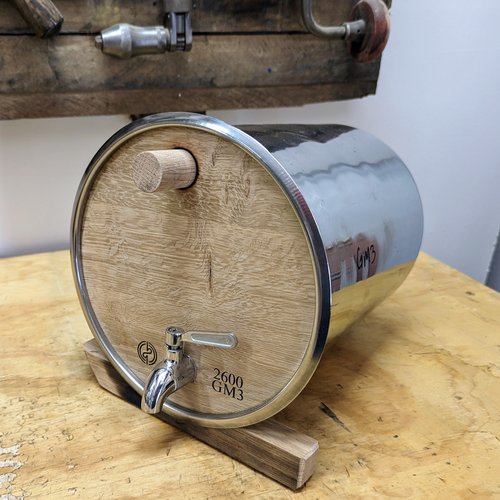About Badmotivator Barrels

Basics
Badmotivator Barrels are built from stainless steel bain marie inserts, fitted with quartersawn American white oak heads. The oak is naturally weathered before use to mellow harsh tannins and encourage the breakdown of wood compounds into flavor-friendly molecules.
Each barrel includes a bunghole and bung for filling and emptying, along with a stainless steel spigot for easy pours. Beeswax is used to seal the joint between the oak head and the steel body to prevent leaks. Since July 2022, each head is held in place with three stainless steel nails to prevent shifting caused by pressure changes during aging.
Surface Area to Volume Ratio
These barrels are designed to mimic the aging conditions of full-sized oak casks used for whiskey, rum, tequila, brandy, and similar spirits. The idea is to match the ratio of oak surface area to liquid volume (SA/V), which plays a big role in how spirits mature over time.
- Our 1.8-gallon barrel has a SA/V ratio of 27.8 in²/gal
- The 5-gallon barrel comes in slightly lower at 23.3 in²/gal
This means you can expect similar results between both sizes, whether you're aging a small test batch or scaling up.
You can also tweak the exposure. If you fill the 1.8-gallon barrel with just 1.25 gallons and store it head-down, the SA/V ratio increases to 40 in²/gal. Drop the fill to 1 gallon, and that ratio jumps to 50 in²/gal. These adjustments give you more control over how fast or intense the oak character develops.
For context:
- A standard 53-gallon American whiskey barrel has a SA/V ratio of about 54 in²/gal when full. But as evaporation (the “angel’s share”) lowers the liquid level, the actual ratio drops.
- Larger casks like puncheons (often used in rum and sherry aging) have much lower SA/V ratios, around 17 in²/gal, leading to slower extraction and gentler wood influence.
In my experience, these barrels strike a good balance. They don’t over-oak or under-oak the spirit. If you’re using well-seasoned oak, the flavors come out rich and layered, not harsh or overwhelming.
-

Maturation
Spirit maturation is a complex subject, and this isn’t the place to unpack it fully. If you want to dig deeper, I recommend checking out Tom Macy's article on Barrel Maturation. It offers a solid overview.
-

Stave Thickness
Standard whiskey barrel staves are usually between ¾" and 1" thick. Badmotivator Barrel heads are about 15/16" thick. I may experiment with thinner stock in the future, but for now, I haven’t found a reason to change.
Footnotes
Barrels in the spirits industry come in all shapes and sizes. Here are a few for reference:
- Quarter Cask – ~13 gallons
- Standard Barrel – ~53 gallons
- Hogshead – ~63 gallons
- Barrique – ~79 gallons
- Sherry Butt – ~130 gallons
- Puncheon – ~123 gallons
- Port Pipe – ~172 gallons
- Gorda – ~185 gallons
As the size increases, the SA/V ratio drops, which slows down aging and can create a different flavor profile. (Source: Difford’s Guide)

